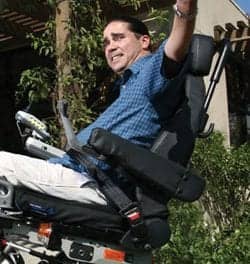While a backpack is still one of the best ways to tote homework, an overloaded or improperly worn backpack gets a failing grade, according to the American Physical Therapy Association (APTA), Alexandria, Va.
Improper backpack use can cause injury, especially to children with young, growing muscles and joints. A study led by APTA member Shelley Goodgold, PT, associate professor of physical therapy at Simmons College in Boston, found that 55% of the children surveyed carried backpack loads heavier than 15% of their body weight, the maximum safe weight for children recommended by most experts.
Injury can occur when a child, in trying to adapt to a heavy load, uses harmful postures such as arching the back, leaning forward or, if only one strap is used, leaning to one side. PTs say these postural adaptations can cause spinal compression and/or improper alignment, and may hamper the proper functioning of the disks between the vertebrae that provide shock absorption. A too-heavy load also causes muscles and soft tissues of the back to work harder, leading to strain and fatigue, which leaves the back more vulnerable to injury. A heavy load may also cause stress or compression to the shoulders and arms. When nerves are compressed, the child may experience tingling or numbness in the arms.
Worn correctly and not overloaded, a backpack is supported by some of the strongest muscles in the body: the back and abdominal muscles, which work together to stabilize the trunk and hold the body in proper postural alignment.
In Goodgold’s study, one-third of the children reported experiencing back pain that had caused them to visit a doctor, miss school, or abstain from physical activities. "While we do not have scientific evidence proving that heavy backpacks cause serious back or other musculoskeletal damage," Goodgold says, "we do know that children who have back pain usually have recurrent problems, and we know that the risk of future back problems increases when a person has had one episode."
PTs recommend the following tips for safe backpack use:
Wear both straps. Using only one strap, even with backpacks that have one strap that runs across the body, causes one shoulder to bear the weight of the bag. By wearing both shoulder straps, the weight of the pack is better distributed, and a symmetrical posture is promoted. A backpack that has padded, contoured shoulder straps will also help reduce pressure on the chest and shoulders.
Make sure the backpack fits. It is important to pay close attention to the way a backpack is positioned on the back, and the size of the backpack should match the size of the child. Shoulder straps should fit comfortably on the shoulder and under the arms, so that the arms can move freely. The bottom of the pack should rest in the contour of the lower back. The pack should "sit" evenly in the middle of the back, not "sag down" toward the buttocks.
PTs recommend the following features when choosing a backpack:
A padded back to reduce pressure on the back and prevent the pack’s contents from digging into the child’s back;
A waist belt to help distribute some of the load to the pelvis;
Compression straps on the sides or bottom of the backpack that, when tightened, compress the contents of the backpack and stabilize the articles; and
Reflective material so the child is visible to drivers at night.
Some children may find backpacks with wheels a good option. Goodgold cautions that wheeled backpacks may present problems such as getting them up and down stairs or trying to fit them into cramped locker spaces. If a wheeled backpack is chosen, Goodgold says to be sure that the extended handle is long enough so that the child is not forced to twist and bend, and that the wheels are sufficiently large so that the backpack doesn’t shake or topple. It is also wise to consider the weight of the backpack when empty. For example, a standard canvas backpack will be lighter in weight than one with wheels.
So how do you make sure that your child stays injury-free? Goodgold says parents should look for the following signs that the backpack is too heavy:
Pain when wearing the backpack;
Tingling or numbness in the arms; and
Red marks on the shoulders.
[Source: APTA]


